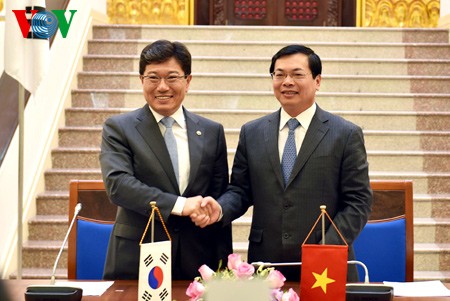(VOVworld) – The Vietnam-Korea Free Trade Agreement has been signed in Hanoi after more than 2 years of negotiations. With a strong commitment from Korea to open its market, Vietnamese businesses are likely to turn this into economic achievements.
 |
At the signing ceremony (Photo: VOV)
|
The comprehensive trade deal between Vietnam and the Republic of Korea is expected to have a positive influence on Vietnam’s economy, trade, investment, and social affairs.
Under the agreement, Korea is committed to cutting 95.4% of all tariff lines, in particular for many key agricultural and aquatic products, textiles, and engineering items.
A tariff line is a product defined in lists of tariff rates, according to the World Trade Organization’s glossary.
These cuts will create gigantic competitive points for Vietnamese exports like shrimp, garlic, ginger, honey, and yams.
In return, Vietnam will eliminate tariffs for 89.2% of its tariff lines, mainly for textile raw materials, electronic components, trucks and passenger cars, automobile spare parts, electrical appliances, some iron and steel products, and power cables.
A majority of these are raw and auxiliary materials imported for production in Vietnam, which will reduce Vietnam’s dependence on imports from other countries.
 |
Industry and Trade Minister Vu Huy Hoang and RoK Minister of Commerce, Industry, and Energy, Yoon Sang-jick at the signing ceremony
|
Minister of Industry and Trade Vu Huy Hoang said:“the FTA will boost exports of Vietnam’s strongest products to the Korean market, especially seafood, agricultural produce, and industrial materials. In return, the volume of Vietnam’s imports from Korea, particularly industrial electronics, garments, textiles, and footwear, will also rise.”
Korea pledged to help Vietnam develop its support industry, which remains weak, according to Minister Hoang.
Generally, the agriculture sector, farmers, rural areas, labor-intensive fields, and the processing industry will be the first beneficiaries of the trade pact.
 |
| Vietnamese goods on display at a supermarket in the RoK (Photo: tuoitrenews.vn) |
Korea is one of Vietnam’s major export markets, accounting for 10% of the total export revenue from garments and textiles, Vietnam’s second biggest hard currency earner. Meanwhile Korea is supplying nearly 20% of all fabric material to Vietnam.
It remains to be seen if Vietnamese enterprises can fully tap the opportunities offered by the deal.
Deputy Minister Tran Quoc Khanh said:“I think domestic companies have made relatively good preparations for grasping the agreement’s opportunities. For example, Vietnam’s exports to Korea grew 16% per year before the ASEAN-Korea trade agreement was signed and 38% the year after. Vietnam’s export to import ratio is now 1 to 3, narrowing from 1 to 5 just a few years ago. It’s believable that the current rapid export growth can reduce Vietnam’s trade gap and balance exports and imports between Vietnam and the Republic of Korea.”
The signing of the agreement is a significant step in Vietnam’s international economic integration strategy. It also supports Vietnam’s restructuring, industrialization, and modernization and helps develop a stable, long-term strategic partnership with Korea.